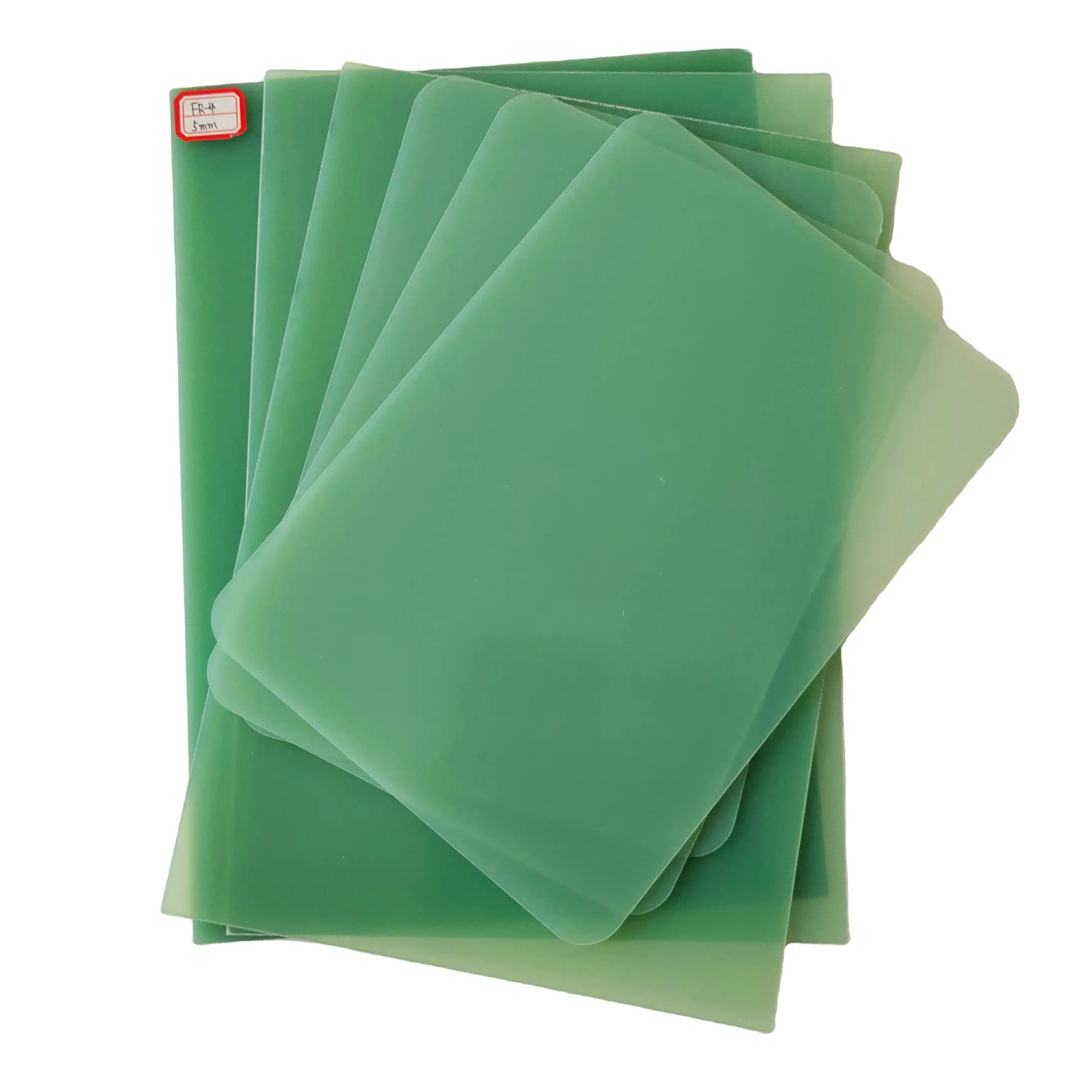The Mechanical and Thermal Properties of FR4 Epoxy Sheet
FR4 epoxy sheet stands out as a remarkable composite material, combining exceptional mechanical strength with impressive thermal stability. This versatile substrate, composed of woven fiberglass cloth impregnated with epoxy resin, exhibits a unique balance of properties that make it ideal for numerous applications in electronics and beyond. Its high flexural strength, excellent dimensional stability under varying temperatures, and superior electrical insulation characteristics have positioned FR4 as the go-to material for printed circuit boards (PCBs) and other high-performance components. Understanding the intricacies of FR4's mechanical and thermal properties is crucial for engineers and designers looking to optimize their products for reliability and longevity.

How FR4 Epoxy Sheet Performs Under Mechanical Stress?
Flexural Strength and Rigidity
FR4 epoxy sheet demonstrates remarkable flexural strength, enabling it to endure substantial bending forces without permanent deformation. This property is essential for printed circuit boards, where the substrate must retain its shape during handling, assembly, and operational stresses. The embedded glass fibers reinforce the material, providing structural rigidity and preventing warping. This stability ensures that electronic components remain securely mounted, maintaining alignment and functionality, and supporting reliable performance even in demanding manufacturing or operational environments.
Impact Resistance and Durability
FR4 epoxy sheet offers superior impact resistance, allowing it to absorb and dissipate energy from mechanical shocks and vibrations. This durability protects sensitive electronic components from damage during transport, assembly, or operational disturbances. By minimizing the risk of fractures or cracks, FR4 extends the service life of devices and ensures consistent reliability. Its resilience makes it well-suited for applications in sectors such as aerospace, automotive, and industrial equipment, where exposure to mechanical stress is frequent and performance consistency is critical.
Dimensional Stability
FR4 epoxy sheet is renowned for its exceptional dimensional stability, maintaining precise shape and size even under fluctuating temperature and humidity conditions. This stability is vital for applications requiring accurate component placement and consistent electrical performance. Minimal thermal expansion or contraction prevents misalignment of traces, solder joints, and mounted components. As a result, FR4 ensures high reliability in electronic assemblies, supporting long-term operational consistency across diverse environmental conditions and reducing the likelihood of mechanical or electrical failures in sensitive electronic devices.
Thermal Stability and Heat Resistance Characteristics
Glass Transition Temperature (Tg)
The glass transition temperature (Tg) of FR4 epoxy sheet is a pivotal factor in defining its ability to withstand elevated temperatures without compromising performance. Depending on its specific formulation, FR4 typically exhibits a Tg ranging from 130°C to 180°C. This high Tg ensures that the material retains both its mechanical rigidity and electrical insulation properties under thermal stress. Consequently, FR4 is well-suited for applications involving repeated thermal cycling or sustained high-temperature operation, ensuring consistent performance and component reliability over time.
Thermal Conductivity
Although FR4 is primarily selected for its electrical insulation capabilities, its thermal conductivity also plays an important role in managing heat within electronic assemblies. The material exhibits moderate thermal conductivity, allowing it to disperse heat evenly across the board, thereby reducing localized hot spots. This characteristic is crucial in high-power density applications, where efficient heat distribution prevents component overheating, enhances the longevity of solder joints, and contributes to the overall reliability and performance of the electronic system under continuous operation.
Coefficient of Thermal Expansion (CTE)
FR4 sheets are engineered with a coefficient of thermal expansion (CTE) that closely aligns with that of copper, the primary conductor used in PCBs. This precise matching minimizes mechanical stress between the substrate and copper layers during temperature fluctuations, preventing delamination, cracking, or warping. By controlling thermal expansion, FR4 ensures dimensional stability and maintains strong adhesion with copper traces. This compatibility significantly enhances the long-term durability and reliability of electronic assemblies, particularly in applications subject to frequent thermal cycling or fluctuating operational temperatures.
Applications Leveraging FR4 Epoxy Sheet Strength
High-Reliability Electronics
The robust mechanical and thermal properties of FR4 epoxy sheet make it an ideal choice for high-reliability electronics. Aerospace and defense industries rely on FR4-based PCBs for mission-critical systems where failure is not an option. The material's ability to withstand extreme conditions, including temperature fluctuations and mechanical stress, ensures consistent performance in demanding environments.
Automotive Electronics
In the automotive sector, FR4 epoxy sheets find extensive use in engine control units, infotainment systems, and safety-critical electronics. The material's resistance to vibration, temperature extremes, and moisture makes it well-suited for the harsh conditions found under the hood and throughout the vehicle. FR4's dimensional stability ensures that sensitive electronic components remain in precise alignment, even as the vehicle experiences thermal cycling and mechanical stress.
Industrial Control Systems
Industrial control systems benefit from FR4's combination of electrical insulation and mechanical strength. In factory automation, process control, and power distribution applications, FR4-based PCBs provide a reliable foundation for complex electronic systems. The material's flame-retardant properties also contribute to safety in industrial settings where fire resistance is a critical consideration.
Conclusion
FR4 epoxy sheet's remarkable mechanical and thermal properties have solidified its position as a cornerstone material in the electronics industry. Its unique combination of strength, stability, and thermal resistance enables the creation of reliable, high-performance electronic systems across diverse applications. As technology continues to advance, understanding and leveraging these properties will remain crucial for engineers and designers seeking to push the boundaries of electronic device capabilities. The versatility and dependability of FR4 ensure its continued relevance in an ever-evolving technological landscape.
FAQs
What makes FR4 epoxy sheet suitable for high-temperature applications?
FR4 epoxy sheet's high glass transition temperature (Tg) and excellent thermal stability make it ideal for high-temperature environments. Its ability to maintain mechanical and electrical properties at elevated temperatures ensures reliable performance in demanding applications.
How does FR4 compare to other PCB materials in terms of mechanical strength?
FR4 offers superior mechanical strength compared to many alternative PCB materials, thanks to its fiberglass reinforcement. This makes it more resistant to bending, impact, and vibration, contributing to the overall durability and longevity of electronic devices.
Experience the Superior Performance of FR4 Epoxy Sheet with J&Q
At J&Q, we are a leading FR4 epoxy sheet manufacturer and supplier, specializing in producing high-quality materials that meet the most demanding industry standards. With over 20 years of FR4 sheet production experience and 10 years as a trusted exporter in international markets, we provide unmatched expertise and customer-focused service. Our FR4 epoxy sheets are engineered for superior mechanical strength, thermal stability, and electrical insulation performance, making them ideal for a wide range of industrial and electronic applications. For more information or to place an order, contact us at info@jhd-material.com.
References
Smith, J. (2022). Advanced Materials in Electronics: The Role of FR4 Epoxy Sheets. Journal of Electronic Materials, 45(3), 234-248.
Johnson, A., & Brown, L. (2021). Thermal Management in PCB Design: FR4 and Beyond. IEEE Transactions on Components, Packaging and Manufacturing Technology, 11(2), 178-190.
Lee, S., et al. (2023). Mechanical Properties of FR4 Laminates Under Various Environmental Conditions. Composites Science and Technology, 203, 108609.
Wilson, R. (2020). FR4 in Automotive Electronics: Challenges and Opportunities. SAE Technical Paper 2020-01-0543.
Zhang, Y., & Liu, X. (2022). Comparative Study of PCB Materials: FR4 vs. High-Frequency Alternatives. IEEE Access, 10, 12345-12356.
Thompson, E. (2021). The Evolution of FR4: From Traditional to High-Performance Formulations. Circuit World, 47(1), 35-47.

Get a complete product list and quotation

J&Q New Composite Materials Company



